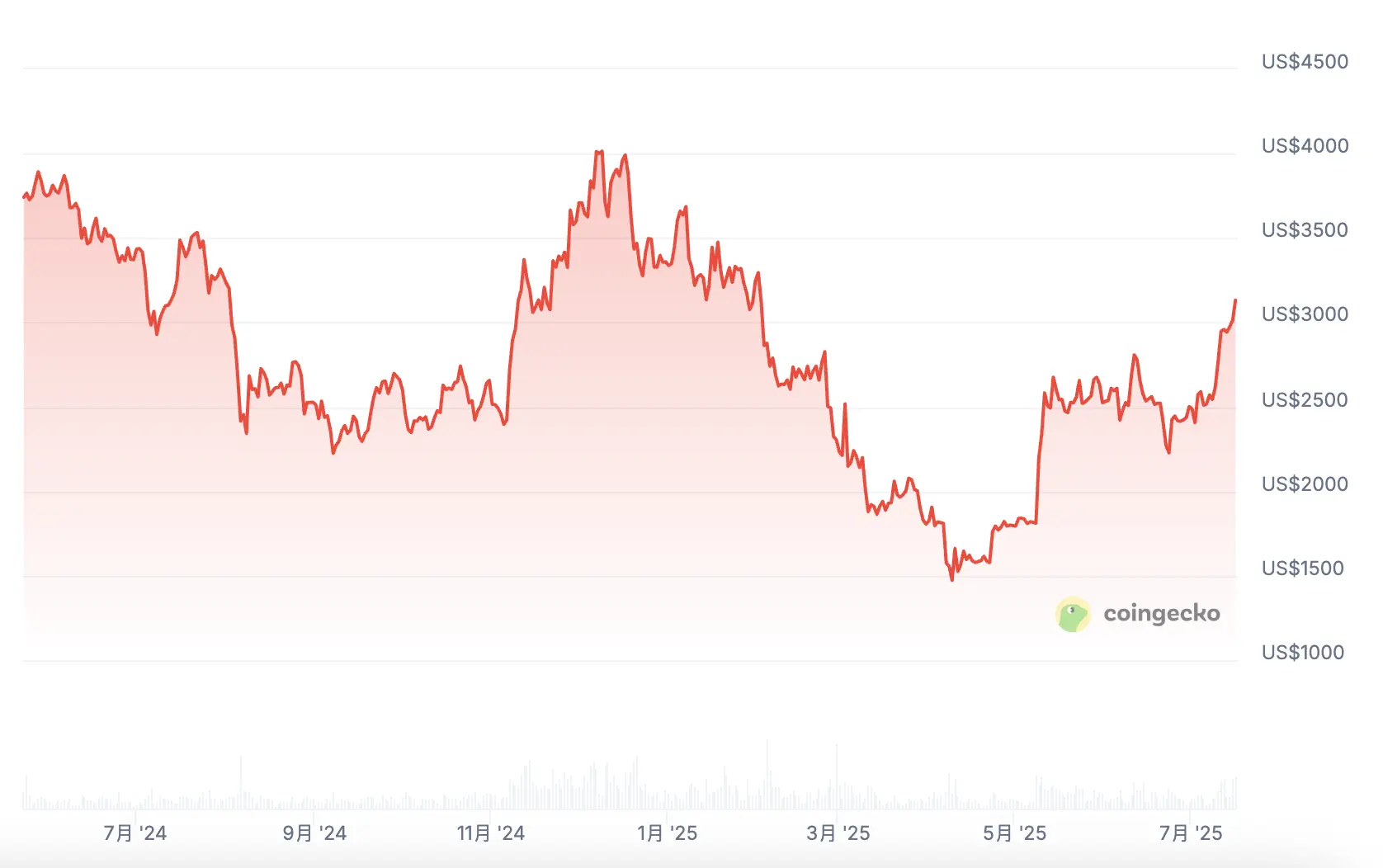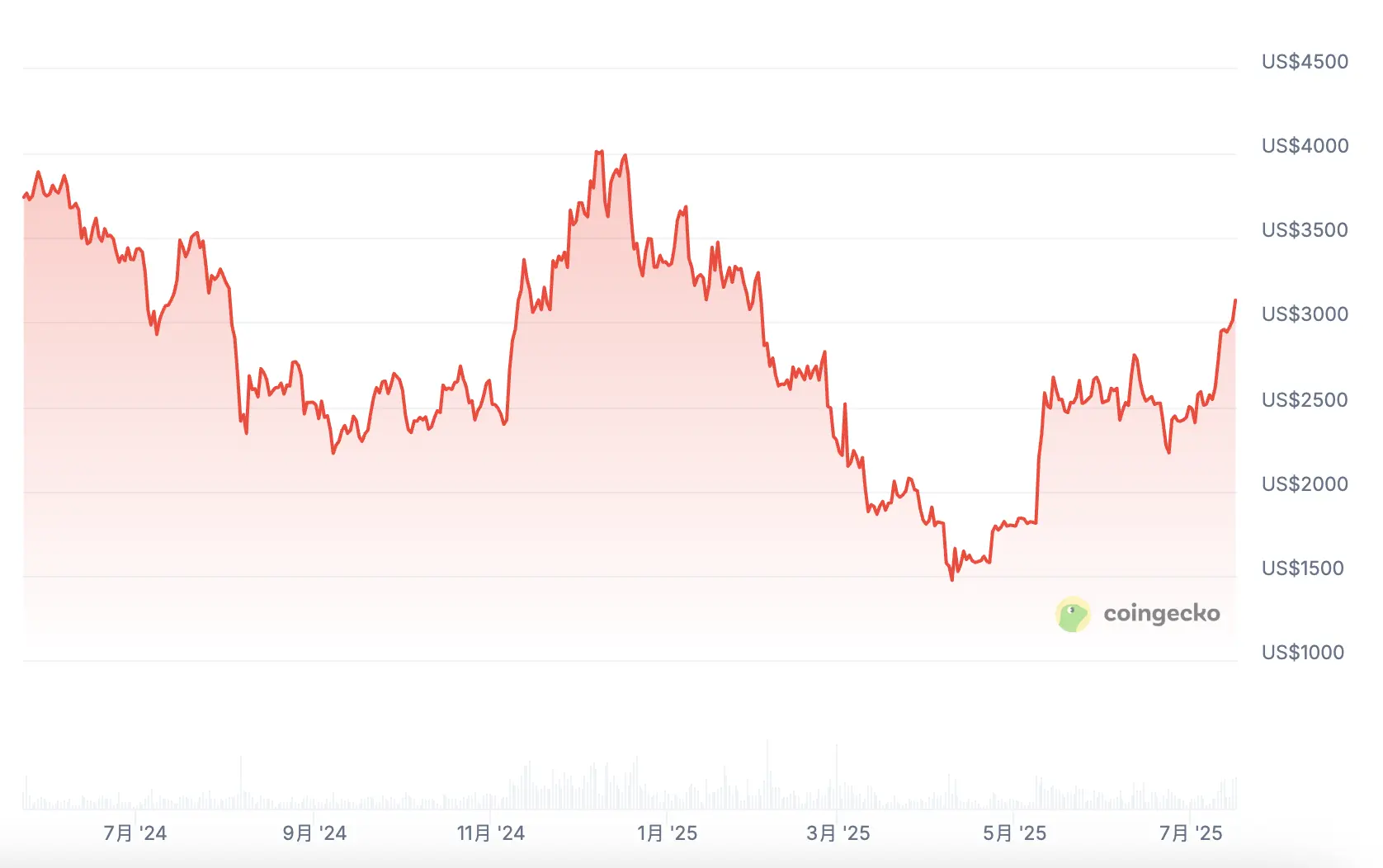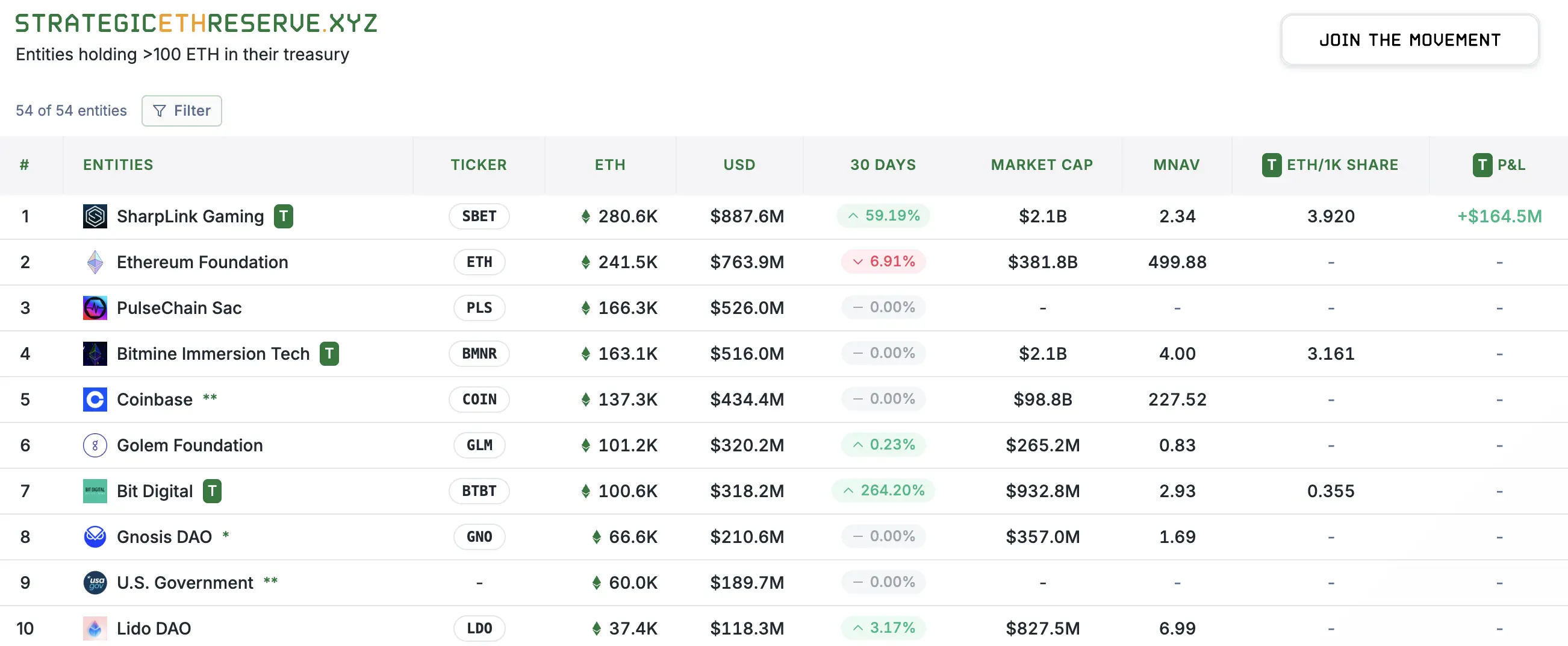Author: Nancy, PANews
In recent days, as the ETH price continues to rise, the arms race for Ethereum reserves has become increasingly fierce, and market confidence has significantly improved. This rebound is largely due to the active influx of institutional capital. However, with more institutional participants accelerating their entry, Ethereum may face a capital shift.
Wall Street enters through ETFs, and the narrative of listed companies reserving assets brings a new turning point
The launch of the Ethereum spot ETF was seen as an important milestone towards Wall Street and traditional finance, with the market widely expecting it to significantly boost the price and ecosystem of Ethereum.
However, since the launch of the Ethereum spot ETF in July 2024, the market has not seen the expected spark; ETH price trends have been weak, and the ETH/BTC exchange rate has continued to decline, significantly impacting investor confidence. At the same time, certain selling actions by the Ethereum Foundation have also sparked market controversy. Although these sell-offs may be due to operational needs, the sensitivity of market sentiment has amplified the interpretation of these actions, leading to a growing chorus of pessimism about Ethereum.
According to SoSoValue data, since the launch of the Ethereum spot ETF (July 23, 2024), a cumulative net inflow of approximately $5.76 billion has occurred, accounting for 3.87% of Ethereum's total market capitalization. From the perspective of capital flow rhythm, in the past 13 months, there were only three months of net outflows, with a cumulative outflow amount of $930 million, showing a generally robust capital absorption trend.

However, the steady inflow of ETF funds provides effective support at the price level of ETH. According to CoinGecko data, from the launch of the ETF until the first ETH reserve company SharpLink Gaming announced the establishment of Ethereum strategic reserves (May 27, 2025), the maximum price increase of ETH was only 16.55%, while the maximum drop reached 63.34%. In contrast, since the launch of the Bitcoin spot ETF on January 11, 2024, BTC price has risen by as much as 153.3%, showing a stronger market performance. The market performance of Ethereum and Bitcoin under the support of ETFs forms a stark contrast.


It was not until the past two months that the market direction began to gradually change. On the one hand, ETH experienced a technical rebound after a deep adjustment; on the other hand, the Ethereum Foundation initiated internal governance mechanism reforms, and listed companies began to include ETH in their balance sheets, injecting a new narrative driving force into ETH.
Since companies like SharpLink Gaming, Siebert Financial, and Bit Digital announced their allocation of ETH, the ETH price recorded a cumulative increase of 22.29% (data as of July 16), significantly outperforming Bitcoin's 7.9% performance during the same period. This round of rebound is built not only on the basis of asset reassessment but also benefits from the gradual formation of a new narrative around strategic reserve assets.
Currently, market sentiment is bullish, for example, ARK Invest founder Cathie Wood recently publicly stated that the long-term value of Ethereum is severely underestimated; Varys venture capital director and Multicoin co-founder are betting on whether ETH can reach $10,000 by the end of 2026. Meanwhile, institutions are accelerating their entry, with the Ethereum spot ETF recording over $1 billion in net inflows for two consecutive months, and Bitwise Chief Investment Officer Matt Hougan even stated that inflows into Ethereum ETFs could significantly accelerate in the second half of 2025.
Institutions hold over 1.6 million ETH, and Ethereum is set to welcome a capital shift
After traditional financial giants like BlackRock, Fidelity, and ARK entered the spot ETF arena, and listed companies began a wave of Bitcoin reserves, the narrative and pricing power of Bitcoin have shifted from the crypto-native community to Wall Street capital.
Currently, this trend seems to be gradually repeating itself in Ethereum, with more and more listed companies making large-scale capital allocations around Ethereum. According to data from Strategic ETH Reserve, there are already 54 entities holding more than 100 ETH, collectively holding over 1.6 million ETH, worth over $5.07 billion, equivalent to 35% of the overall size of the ETH ETF. In the past two months, listed companies such as SharpLink Gaming, BitMine, Bit Digital, BTCS, GameSquare, and Bit Digital have announced plans to include ETH in their company balance sheets.

From the current composition of institutions entering Ethereum, they can be mainly divided into two camps. One side is represented by SharpLink, backed by Ethereum supporters such as ConsenSys, Galaxy Digital, Pantera Capital, and Electric Capital, which is considered a collective self-rescue of early native forces in the Ethereum ecosystem. As of now, SharpLink has accumulated over 280,000 ETH, surpassing the 242,500 ETH held by the Ethereum Foundation, becoming the world's largest institutional holder of ETH.
The other camp is represented by BitMine, which adopts a Wall Street approach by replicating Strategy's reserve logic for Bitcoin, including ETH in their financial reports and leveraging it for acquisition. This institution is backed by Wall Street strategist and Ethereum enthusiast Tom Lee, who, while retaining Bitcoin mining operations, has included ETH in the company balance sheet, currently holding over 160,000 ETH, ranking among the top five globally.
If the positions of these institutions continue to expand, the pricing power, discourse power, and even governance power that were originally held by developers, core researchers, the Ethereum Foundation, and early OG investors may face a reshuffle. However, from the current listed companies allocating ETH, most are generally facing financial pressure, aiming to hedge against inflation, boost stock prices, or seek short-term excess returns, especially with the successful case of Strategy, they have yet to demonstrate a willingness to deeply bind with Ethereum's ecological construction. At the same time, these institutions struggle to compete with leading institutions in terms of allocation size, risk tolerance, and holding periods, limiting their substantive influence on Ethereum's ecological governance and long-term development. In other words, those with strong financial strength will still be the ones able to dominate the future direction of the Ethereum ecosystem.
Moreover, unlike the Bitcoin reserve trend with figures like Michael Saylor (CEO of Strategy) as the soul evangelist, Ethereum has yet to see a character who possesses both faith attributes and traditional capital influence. Whether Tom Lee can become a role similar to Saylor remains to be seen. This somewhat limits Ethereum's overall dissemination power as an institutional asset in mainstream capital markets.
Of course, the Ethereum official has an open attitude towards institutional allocations. Ethereum founder Vitalik Buterin recently stated that institutions choose Ethereum because it is stable, secure, does not crash, and has a clear technical roadmap; while the new co-executive director of the Ethereum Foundation, Tomasz Stańczak, pointed out that the reason institutions favor ETH is due to its 'ten years of uninterrupted operation, continuous upgrades, and commitment to censorship resistance and security.'
However, Vitalik recently emphasized the importance of a dual governance mechanism and decentralization, pointing out that dual governance provides an additional layer of independent defense to prevent the system from taking particularly harmful actions, while explicitly including Ethereum users as stakeholders rather than relying solely on informal alignment based on 'atmosphere'. He also stressed that if decentralization remains merely a slogan, Ethereum will face a survival crisis.
Overall, with Ethereum initiating a reserve trend, market attention and liquidity have undoubtedly significantly increased. However, if the price increase lacks strong support from actual ecological activity, it will ultimately be just an illusion, difficult to sustain. The core driving force for the stable growth of ETH value remains the continuous innovation and increased activity within the Ethereum ecosystem, which directly determines the frequency of network use and value accumulation. Currently, the Ethereum Foundation is focused on deep reforms in organizational structure, ecological collaboration, and technological evolution, aiming to reshape ecological dominance, strengthen governance effectiveness, and reverse the negative perceptions of Ethereum from the outside.




